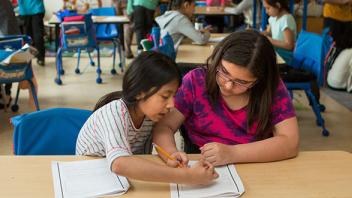As the school year begins, special and general education teachers must consider how the educational needs of students with autism spectrum disorder will be met across a variety of instructional settings. Questions arise about who will support the student during classroom instruction, in the resource room, at lunch time, and during special activities.
In addition, involvement of students with autism spectrum disorder in extracurricular and after school activities becomes a primary concern. One strategy that has been successful is the use of peers. Regardless of the grade level or the area of need, peers have been crucial in helping students with autism spectrum disorder to succeed in typical school and community activities.
Here are some suggestions for using peer supports in your school:
- Involve students with autism spectrum disorder in cooperative play and shared learning arrangements during the early childhood and elementary school years. Pair elementary age students with autism spectrum disorder with buddies while walking down the hall, when playing on the playground, and during other unstructured times of the day. To prevent dependence on one child, vary buddies across time and activities.
- Build cross-age peer/buddy supports by assigning older stu dents to assist a student with autism spectrum disorder with classroom activities. For example, fifth graders can be used to help first graders.
- Assign peers to help the student become acclimated to their new setting when a student with autism spectrum disorder transitions to a new school.
- Assign peers at the middle and high school level to instruct students with autism spectrum disorder in classroom activities. The peer can be seated next to the student with autism spectrum disorder and assist with keeping him/her on task and with completing assigned work.
- Provide individualized instruction through peer support in a resource area of the school.
- Pair students with autism spectrum disorder with peers while attending special school events such as school assemblies and clubs.
- Facilitate students’ involvement in after-school or extracurricular activities, such as school dances and athletic events by using peers. These arrangements can serve as the basis for a real friendship.
- Recruit peers to assist students with autism spectrum disorder in completing homework assignments. Peers can be recruited by family members to further tutor students at home.
- Assist students with autism spectrum disorder in supporting their classmates. Utilize the strengths of specific individuals with autism spectrum disorder to build relationships with peers. For example, a student with autism spectrum disorder who excels in computers can teach his/her classmates how to use a computer.
Peer support can serve a variety of functions for students with autism spectrum disorder in the school community. With the ever expanding and varied needs of students, peer support programs become a necessary strategy to ensure that all students with autism spectrum disorder gain maximum benefit from the school day and peers benefit as well by learning to support the varying needs of their classmates with disabilities.
Through these experiences, nondisabled peers can ultimately become better informed citizens and community members among a diverse society.
